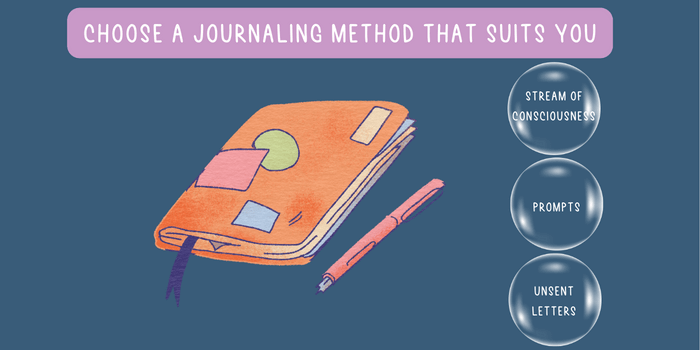Have you ever thought about having a chat with your younger self, maybe giving them a piece of advice or two? Or how about a sneak peek into the future to see what’s in store?
Well, that’s what journaling can do for you. It’s like a daily heart-to-heart with yourself. With each entry, you’re communicating with your past, present, and future self, creating a tapestry of thoughts, dreams, and memories.
In this post, we’re going to chat about some practical ways you can start your own dialogue through journaling. We’re talking about real, everyday strategies that will help you make journaling part of your routine. Just like that morning cup of coffee or tea, let’s make journaling an indispensable part of your day.
Journaling: Your personal time machine
Your journal ends up becoming your personal time machine. With it, you can go back to relive special moments, revisit decisions, and see how you’ve grown over time.
Remember the first day at your job? Or that trip where everything went hilariously wrong but you ended up having a blast? All these memories get a new life in your journal.
But it’s not just about the past. Your journal is also a ticket to the future. You can pen down your dreams and goals, making them feel more real and achievable. Plus, it can be quite exciting to flip back and see how far you’ve come.
Whether it’s learning from past mistakes or planning for upcoming events, your journal acts as a bridge, connecting your yesterdays, todays, and tomorrows.
It’s worth building this wonderful habit which you will come to cherish a few years down the road.
Tip #1: Find your ‘why’
Why do you want to journal?
This is not a trick question. Your ‘why’ is like your personal journaling compass. It’s what will keep you motivated on the days when you don’t feel like writing.
For me, journaling started as a way to manage stress. Pouring my thoughts onto paper felt therapeutic. It was like having a patient, non-judgmental friend who was always ready to listen.
Your ‘why’ could be anything. Maybe you want to capture fleeting ideas, document your personal growth, or simply have a space to vent. There’s no right or wrong answer here. Your journal, your rules.
Remember, your ‘why’ is your guiding star in this journey. So spend some time reflecting on it. You might be surprised by what you discover.
Tip #2: Choose a journaling method that suits you
For the second tip, we’re focusing on choosing a journaling method that fits you like a glove. It’s pretty much like choosing your favorite type of pizza. Everyone has their own preferences, right?
For instance, one of my friends is all about digital journaling. She likes typing away on her laptop, adding entries to her journaling Google doc. The ease of editing, the spell check, and the comfort of her keyboard make the experience enjoyable for her.
But me? I’m a bit of a traditionalist. I absolutely love the charm of a pen-and-paper diary. The feeling of a smooth pen on crisp paper is magical to me. It feels more personal and intimate. I believe it connects me more to my thoughts and feelings.
Now, let’s talk about different types of journaling. You can follow the stream of consciousness approach, where you write freely about whatever comes to mind, with no editing or censoring. This can be a great way to untangle your thoughts and make sense of your feelings.
Alternatively, you can use prompts, which are like little nudges to guide your writing. Prompts can be especially useful if you’re feeling stuck or don’t know where to start. You can find tons of journaling prompts online, from “Describe your perfect day” to deeper ones like “What are you most afraid of and why?”
Or, you could try writing unsent letters. These could be letters to your past or future self, or to other people in your life. They can be a great tool for expressing and processing your emotions.
Remember, there’s no one-size-fits-all approach to journaling. Try out different methods and see what resonates with you.
HabitStrong’s Journaling Program explores 8 powerful journaling techniques and carefully curated prompts to help you find what suits you. Once you find your fit, journaling will feel much more enjoyable and natural.
Tip #3: Create a sacred space for journaling
Setting up a dedicated space for writing, be it a quiet corner in your home or your favorite bench in the park, can make your journaling journey more inviting.
I have a little nook in my home, right next to the window that overlooks the garden. It has a comfy chair, a small table, and a little box where I keep my journal and pens. Just sitting there with my cup of coffee makes me feel cozy and relaxed. The outside view adds a touch of nature and helps my thoughts flow. It’s my own little sanctuary.
But your sacred space doesn’t have to be fancy or elaborate. It could be as simple as your kitchen table early in the morning before everyone wakes up or a certain spot on your couch with your favorite blanket. The important thing is that it feels comfortable and inviting to you.
This space acts as a physical reminder to write. Every time you see it, your brain gets a gentle nudge: “Hey, it’s journaling time.” Moreover, it’s a space that encourages you to slow down, to connect with yourself, and to let your thoughts flow freely.
Remember, it’s not just about the physical location; it’s about creating a mental space too.
Tip #4: Include journaling in your day using the power of habit
You know how brushing your teeth is just something you automatically do in the morning? No thoughts, no deliberations, right? You just do it. That’s the kind of rhythm we’re aiming to build with journaling.
I started by tying my journaling to my morning coffee ritual. While waiting for my coffee to brew, I would sit in my cozy journaling corner and start writing. The aroma of coffee in the air, the quiet of the early morning – it all set the mood for a peaceful journaling session. The best part? My mind began to associate coffee brewing with journaling. So, as soon as I smelled coffee, it was like a cue to start journaling.
You could pair journaling with any routine that suits you – maybe right before bedtime as a way to wind down, or during your lunch break as a moment of midday reflection.
The trick is to connect it to something you already do habitually. This helps cement journaling into your daily routine, making it feel less like an additional task and more like a natural part of your day.
Tip #5: Start small
If the thought of filling pages feels intimidating, believe me, you’re not alone. I remember when I first started journaling, the sight of a blank page was more scary than exciting. It felt like the page was challenging me: “Can you fill me up?”
But here’s a secret: You don’t have to write a novel. Even a single sentence a day is a step toward a consistent journaling habit. Start by jotting down a single thought, a single moment, or a single gratitude.
I started with just three lines a day, acknowledging my daily challenges and how I’m feeling. Sometimes it was about something that made me smile. Before I knew it, those three lines were growing into paragraphs, and those blank pages didn’t seem so daunting anymore.
Remember, journaling is not a sprint, but a marathon. The aim is not to write a lot, but to write consistently. As your comfort grows, so will your entries. So, go ahead and start small. Every sentence you write is a victory in itself. After all, the mightiest rivers start from small streams, don’t they?
Tip #6: Keep it private and judgment-free
Consider your journal a safe harbor, a place where your thoughts can flow freely without fear of judgment or criticism. It’s a space where you can be your most authentic self, no holds barred.
When I write in my journal, it’s like having a conversation with a wise old friend. Someone who listens without interrupting, doesn’t judge, and keeps all my secrets. This perspective frees me to express my thoughts and feelings openly. I can delve into my fears, my dreams, my joys, and my disappointments without restraint.
The privacy of your journal allows you to be honest, maybe more honest than you’ve ever been. It can be liberating to dissect your feelings, explore your thoughts, and be open about your desires, knowing no one else will read these words.
And most importantly, don’t judge yourself. Perfect grammar, fancy words, and coherent paragraphs are not required. It’s about expressing what’s in your heart. Don’t censor yourself, let your thoughts flow with the freedom of a bird in the open sky. Let your thoughts fly high. Your journal is your safe sky, a space wide open just for you.
Tip #7: Embrace imperfection
The beauty of embracing imperfection can truly liberate you in your journaling journey, enabling your authentic voice to emerge.
If I had to pick one thing I love most about journaling, it’s that it’s perfectly okay to be imperfect. Misspelled words, crossed out lines, unfinished sentences – they’re all part of the process. In my journal, I don’t stress about my handwriting or worry if my sentences sound smart. It’s just me, raw and unfiltered.
One of the most freeing moments in my journaling journey was when I realized that I don’t have to write perfectly to write meaningfully. A messy entry filled with genuine emotions and thoughts is worth a dozen flawlessly penned pages that don’t resonate with your heart.
So, as you start or continue your journaling journey, embrace the messiness. Welcome the mistakes. Celebrate the crossed-out words and the scribbles. They’re all part of your authentic voice, your unique story.
Remember, perfection is not the goal here. Expression is. In the world of journaling, it’s the wobbly, uneven steps that often take you the furthest. So embrace the beautiful imperfection of your journey.
After all, it’s the cracks that let the light in, right?
The journey begins with you
From understanding your ‘why’ to embracing imperfection, these seven practical tips can help you make journaling a part of your daily routine. But let’s not forget – this isn’t just about routines or habits. This is about you, your thoughts, your feelings, your stories.
Maybe you’re a fan of pen and paper, like me, or perhaps you prefer typing away on your laptop, like my friend. You might find solace in a quiet corner of your house, or maybe your thoughts flow freely amidst the hustle and bustle of a coffee shop. Maybe you write three lines a day, or perhaps you fill up pages.
Regardless of how you choose to journal, remember one thing: this is your journey. It’s not about comparing your progress with others or striving for perfection. It’s about exploring your inner world, understanding yourself better, and expressing your authentic self.
If you found these tips useful and want to dive deeper into the world of journaling, check out our Journaling Program. In it, we explore eight powerful journaling techniques, from stream of consciousness writing to gratitude journaling and beyond. This program is designed to help you discover the journaling style that fits you best. So, if you’re interested in finding your perfect journaling fit, give our program a go.
Happy journaling!
This article was written by Nisha Salim





